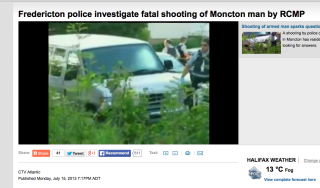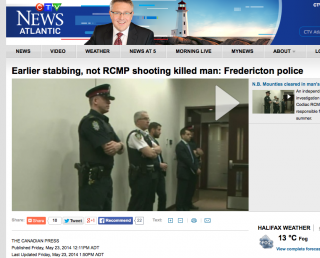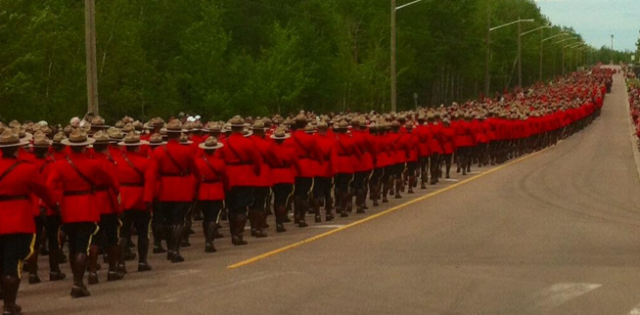 Who Will Benefit and Who Will Lose From the Way the Triple Loss of RCMP Lives is Being Spun?
Who Will Benefit and Who Will Lose From the Way the Triple Loss of RCMP Lives is Being Spun?
On June 10 a huge regimental funeral hosting about 7,000 officers of the Royal Canadian Mounted Police took place in Moncton New Brunswick. Its public purpose was to mourn the three fallen RCMP officers who emerged dead from an alleged shooting rampage widely reported to have been carried out by lone gunman, 24 year old Justin Bourque. Mr. Bourque has been widely reported to have walked fully armed through the Moncton trailer park where he lived. At least three residents of the trailer park have gone on camera to explain what they saw.
Each of the three commentators came up apparently independently with the same observation that Mr. Bourque had a look in his face that announced he was “on a mission.” It has been widely reported that Mr. Bourque was a cadet in the Canadian Armed Forces and was well known as a hunter and expert marksman.
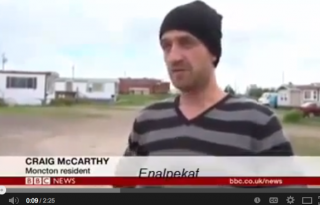
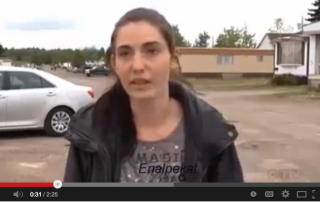
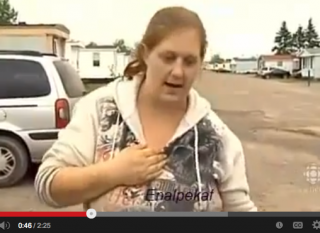 https://www.youtube.com/watch?v=_OP3M3tqrKQ
https://www.youtube.com/watch?v=_OP3M3tqrKQ
Later in the evening reports flooded into the Canadian media that three RCMP police officers had been shot dead by the alleged shooter and that two or three Mounties had been wounded. Mr Bourque was reported to have eluded police all day Thursday. He was apprehended at 12:10 am on Friday June 6. Some reports say he gave himself up. The media’s main witness of the arrest is Michelle Thibodeau, a trained professional actress.

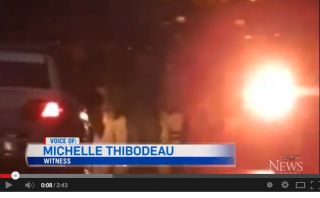 https://www.youtube.com/watch?v=BSo3r4pskv0&list=UUUpHmLISgv8WBxMda0Ob7gQ
https://www.youtube.com/watch?v=BSo3r4pskv0&list=UUUpHmLISgv8WBxMda0Ob7gQ
Mr. Bourque was taken taken to the RCMP detachment in nearby Sackville. Days before the lethal event an emergency exercise or drill had taken place in Sackville including possible responses to a hypothetical shooter or to shooters. When I first reported this drill in my earlier article, “A Canadian Rambo,” one commentator from New Brunswick indicated to me that such drills take place every month in Sackville.
Of course course this episode has generated huge media coverage in Canada as well as numerous reports in the United States and throughout the world. I have chosen to focus particularly on the profile done by a veteran reporter of the Canadian Broadcasting Corporation, Adrienne Arsenault.
Ms. Arsenault’s CBC report encapsulates much of the tone and content of the sensationalistic reportage that has flooded into the airwaves and print media of Canada. Ms. Arsenault’s CBC report was first broadcast on June 5, the day Justin Bourque is reported to have eluded RCMP capture in the small city of Moncton. Mr. Bourque’s elusiveness caused him to be dubbed the Canadian Rambo.
Adrienne Arsenault’s CBC profile of Justin Bourque
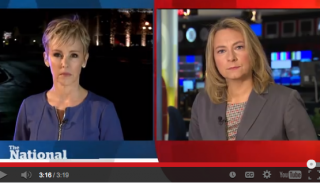
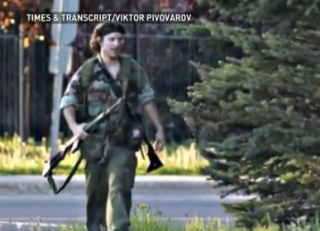
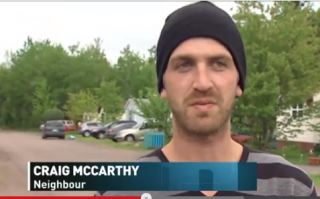
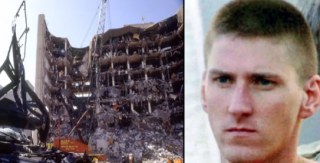
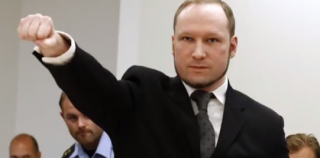
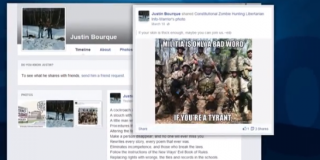 https://www.youtube.com/watch?v=Krf-Qboan5c
https://www.youtube.com/watch?v=Krf-Qboan5c
Ms. Arsenault’s CBC report was researched, filmed, edited, broadcasted, and posted on You Tube on June 5, the day after the RCMP officers were reported dead but before the alleged shooter was apprehended in the early minutes of June 6. This feat of TV reporting is truly an example of lightening fast journalistic work on a very serious subject. The comment section on the You Tube was disabled by the Canadian Broadcasting Corporation..
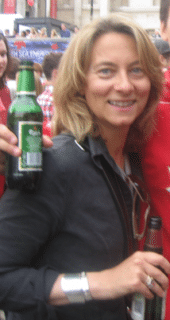
As the images above indicate, Ms. Arsenault’s report associated Mr. Bourque’s alleged crimes with the bombing of the Alfred P. Murrah Federal Building in 1995. Timothy McVeigh was convicted of being the bomber. Ms. Arsenault also associated the allegations against Mr. Bourque with the mass murder in 2011 of 77 victims including a large part of the youth leadership of Norway’s main social democratic party. Anders Behring Breivik was found guilty of this appalling and many-faceted crime.
In her report Ms. Arsenault bases these associations on the conclusions of so-called “experts” in a field she identifies simply as “extremism.” This use of anonymous expert opinion, completely without even a hint of specific attribution and citation, constitutes highly unethical and unprofessional journalistic conduct. This gross lapse of journalistic judgment is especially striking in a story where politically-loaded accusations are being directed against an accused individual who has no opportunity to speak on his own behalf or through a legal representative.
This kind of journalistic misconduct epitomizes the main motifs of trial by media, unfortunately a ubiquitous hallmark of mainstream media venues these days. The journalistic profession, however, has no genuine code of ethics for the identification, prohibition, and punishment of malpractice. There is no real line anymore between PR spin doctors, paid agents, and news reporters. The trend extends to publicly-funded Crown broadcasters including the CBC, BBC, and the Australian Broadcasting Corporation. The extension by the CBC and many other media venues of the techniques of yellow journalism and Red-Scare journalism to this blood-soaked case eliminates the possibility that the accused can get a fair trial with a neutral judge and an unbiased jury. Perhaps this outcome is intentional rather than inadvertent.
Justin Bourque and the Death of Daniel Levesque While in RCMP Custody in 2013
Adrienne Arsenalt’s report is representative of the growing resort to pseudo-psychology by media and police in invented professional fields as contrived as “extremism” or “conspiracy theories.” As Ms. Arsenault’s report well illustrates, this approach is a politically-driven replacement for genuine and honest investigative reporting in this post-9/11 era of the so-called Global War on Terror.
Rather than resorting to this kind of dubious methodology in the construction of her media case against Mr. Bourque, the veteran CBC reporter would have been much better served to have considered explicitly the possible effects on the alleged shooter of the death of his friend, a 30-year-old Moncton man named Daniel Levesque. In 2013 Mr. Levesque was stabbed in the course of an event that was described by police as an attempt to rob a car. When he was delivered dead to the hospital and then the coroner, Mr. Levesque had four gunshot wounds from RCMP fire.
The two Moncton RCMP officers involved in the case were removed from active service until members of Fredericton police force completed an investigation. On May 23 the verdict was delivered. The Fredericton police investigators ruled that the RCMP shooters of Mr. Levesque were guilty of no wrongdoing because the deceased man was already dead when he was pumped with police bullets.
Adrienne Arsenault was clearly aware of these facts when she did her June 5 CBC profile of Justin Bourque. Ms. Arsenault indicated that Mr. Bourque’s attitude changed radically– that he developed “a fury about police”– a year before his day of infamy. In other words, Mr. Bouque’s distrust of the criminal justice system became quite intense around the time his friend, Mr. Levesque, died while being apprehended by the RCMP.
Before launching into the section in her CBC profile where her anonymous experts present their psychological theories about the similarities linking Justin Bourque’s alleged lethal actions to the crimes for which Timothy McVeigh and Anders Breivik have been found guilty, Ms. Arsenault tried to cover herself. She indicated that some unnamed Moncton RCMP officers had been “cleared two weeks ago” of any “wrongdoing” after being involved in a “very high profile and controversial shooting’ that “may or may not” have been a factor in “what’s been happening.”
These phrases could be interpreted as weasel words meant to provide legal protection for Ms. Arsenault and the CBC, not meaningful explanations of the most plausible single explanation for Mr. Bourque’s alleged actions. Of course these alleged actions must be roundly condemned if and when it is proven beyond a reasonable measure of doubt that the accused man actually did the acts of which he now stands accused by the Crown.
In Ms. Arsenault’s report there was no explicit mention of Mr. Levesque and the precise circumstances of his death, no mention of the friendship between Mr. Bourque and Mr. Levesque, and no mention of the controversy surrounding not only the police bullets pumped into Mr. Levesque but the even larger controversy surrounding the finding of “no wrongdoing” by one group of New Brunswick RCMP investigating another group of New Brunswick RCMP.
Withholding Vital Information
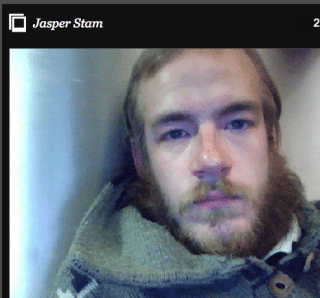 This huge and telling gap in the media coverage of the alleged shooter accused of killing and wounding five RCMP officers is understandably creating consternation in some circles. Robert Brook, for instance, posted on Facebook that “a friend of Justin was killed in an encounter with the RCMP last year.” He added, “We’re not seeing a lot of media coverage of this connection.” Jasper Stam, whose case will be considered in more detail below, is reported to have made a similar posting indicating “I’m sorry for the lack of mercy that people are displaying for him [Mr. Bourque] and for the friend he lost and for the the lack of justice in this world.”
This huge and telling gap in the media coverage of the alleged shooter accused of killing and wounding five RCMP officers is understandably creating consternation in some circles. Robert Brook, for instance, posted on Facebook that “a friend of Justin was killed in an encounter with the RCMP last year.” He added, “We’re not seeing a lot of media coverage of this connection.” Jasper Stam, whose case will be considered in more detail below, is reported to have made a similar posting indicating “I’m sorry for the lack of mercy that people are displaying for him [Mr. Bourque] and for the friend he lost and for the the lack of justice in this world.”
While any serious consideration in the mainstream media of the relationship of Levesque’s death to the Moncton shooter story has been muted, ill-explained, or absent altogether, the same is not true of some alternative media venues. For instance on June 6 Daniel Johnson of the Media Coop, a Canadian based, reader-supported venue whose “contributers want to cover stories free from the constraints of the corporate press,” addressed the tragedy in Moncton. Johnson wrote, “As the media wolves circle around Justin Bourque and fabricate the least sympathetic motives they can come up with to project onto his actions, a handful of news commenters have posted and re-posted stories about the murder of Daniel Levesque, who may have been a close friend of Justin Bourque, on July 13, 2013 by Moncton RCMP, and the subsequent ‘investigation’ that, like virtually every other time police investigate other police, found the officers did nothing wrong.”
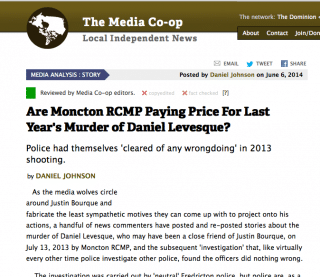
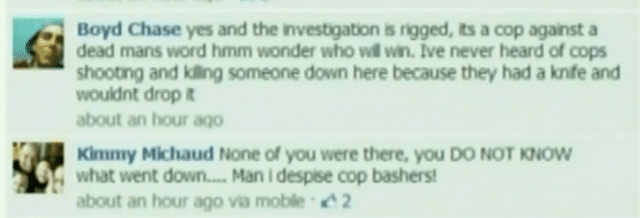
Johnson equated the death of Daniel Levesque to the similar circumstances he saw in the death of Ian Bush in British Columbia. In both instances, Johnson alleges, “the victim was kneeling when he was shot in the back of the head.” The Media Coop writer continues, “We see all the pictures of the crying families of RCMP every time one of them dies, but when the RCMP kill someone we rarely see pictures of their families in the days after. No publicly funded memorials for Daniel Levesque and Ian Bush, no moral prattling by Conservatives about the value of human life when they were killed in cold blood by ‘public servants’.”
Sources, Uses and Possible Abuses of the Iconographic Photograph
As far as I can see the most damning single piece of evidence in the trial by media of Justin Bourque has been the iconographic photograph of him. Mr. Bourque is pictured seemingly starting out his day, walking through the trailer park fully armed with guns, bow and arrow, and ammo. This image makes convincing the lethal sequence of events reported to have happened next, events about which by and large have been explained to us orally but without clear supporting imagery. As if to cover all the bases, the photographer was able to swing around behind Mr. Bourque to capture an illustrative picture of what the marksman was carrying on his back. Mr. Bourque seems totally unconcerned, perhaps even unaware that he is being photographed.
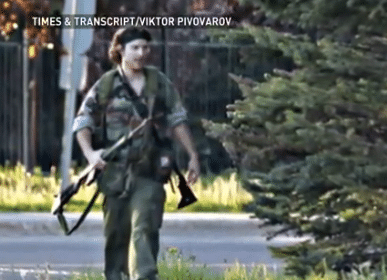
The main image of the alleged Moncton shooter pictured allegedly starting his most notorious day is now deeply embedded in the consciousness of most Canadians and of many individuals outside Canada as well. For those without the time or inclination to bring skepticism to the official account of what happened subsequently, the iconographic picture seems on the surface to seal the deal in the trial by media.
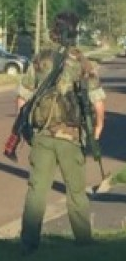 We are assured by official sources that the photograph was snapped on Wednesday June 4, 2014. Maybe so. But what is the proof that the photograph was taken on the lethal day and not, say, weeks earlier as the marksman and hunter went off to meet up with friends to hunt deer or to hang out at a shooting range or both?
We are assured by official sources that the photograph was snapped on Wednesday June 4, 2014. Maybe so. But what is the proof that the photograph was taken on the lethal day and not, say, weeks earlier as the marksman and hunter went off to meet up with friends to hunt deer or to hang out at a shooting range or both?
In Adrienne Arsenault’s June 5 profile piece the now-famous introductory picture was shown and then a slide was superimposed with the words Times and Transcript/Vicktor Pivorarov. A quick google search reveals that the Times and Transcript is the local Moncton newspaper. Another search shows Vicktor Pivovarov to be a professional photographer based in Moncton. Fine so far.
On June 6 the Washington Post ran a piece by Lindsey Beaver entitled, “Mounties Arrest Rambo-style Suspect in Triple Cop Killing.” Embedded in the article was a video done by Post TV. The narrator of this video showed the iconographic picture and then announced, “Reuters is unable to confirm its authenticity.” Consider that. One of the world’s major news organizations tried to confirm the authenticity of this widely disseminated photograph but could not come up with satisfactory answers to the necessary questions that all outlets running the damning photograph should have asked.
For whom was Vicktor Pivovarov, presuming it was Vicktor Pivovarov, working when he grabbed the damning image?  Who gave the photographer the lead of where to intersect with the heavily armed trailer park resident? Was the picture taken secretly or in full view of Mr. Bourque, presuming the pictured person is indeed Mr. Bourque? Many news reports indicate that the picture was quickly and massively disseminated by the RCMP. Why? What was the objective? What is the relationship between Mr. Pivovarov and the RCMP? Is the RCMP a regular patron of his?
Who gave the photographer the lead of where to intersect with the heavily armed trailer park resident? Was the picture taken secretly or in full view of Mr. Bourque, presuming the pictured person is indeed Mr. Bourque? Many news reports indicate that the picture was quickly and massively disseminated by the RCMP. Why? What was the objective? What is the relationship between Mr. Pivovarov and the RCMP? Is the RCMP a regular patron of his?
Was it the RCMP or the Times and Transcript or both that gave Mr. Pivovarov the tip of where to go to capture the picture. Might things have turned out very differently if those involved had put the priority on apprehending Mr. Bourque rather than photographing him? With such early, clear and graphic evidence that Mr. Bourque was well equipped for a gun fight, why were RCMP apparently so unprepared for what is alleged to have happened when RCMP members placed themselves within the range of fire of the well-armed man?
Why haven’t such basic questions received a hearing as part of the proceedings in the the trial by media? What is preventing the media representatives who have access to the RCMP’s spokespersons from asking hard questions about the policing decisions from June 4 to June 6. It would seem there is probably plenty of responsibility at many levels in the chain of command for the lethal events that transpired.
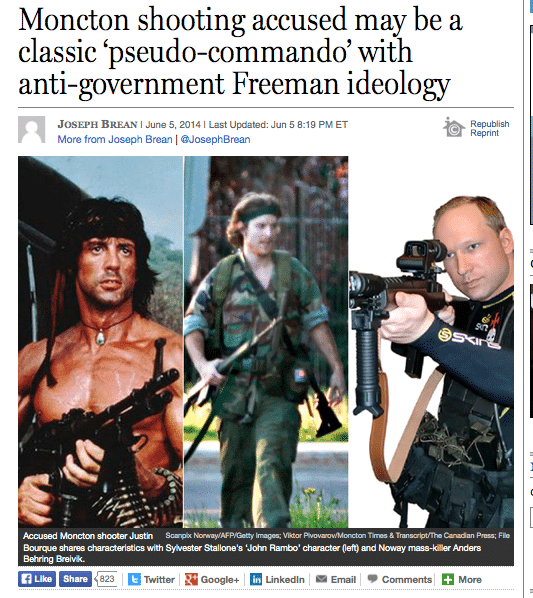
The Case of Jasper John Stam
Jasper John Stam spoke well on Facebook of Justin Bourque. One June 7 Mr. Stam made the following Facebook post:
The same day Mr. Stam also posted the following:
On Monday June 9 Jasper Stam was arrested by the RCMP and charged by the Crown with uttering death threats concerning RCMP officers sometime in mid-May. The judge sent Mr. Stam for a mental evaluation to consider if he is of sufficiently sound mind to go through a trial. Mr. Stam was also prohibited from having any contact with Mr. Bourque.
The timing of the charge suggests the length to which Crown officials are willing to go to put a freeze on community discussion of the very difficult issues raised by what transpired between June 4 and June 6 as well as the context of the debacle. Of course police, whose jobs are sometimes difficult and unusually dangerous, have every right like all Canadian not to be subjected to threats and intimidation.
But what signal is sent by putting a red circle around an alleged speech crime in the case of Jasper Stam? Could this Crown prosecution be interpreted as an announcement that the spirit of crackdown and repression is to be encouraged rather than an atmosphere for the airing of legitimate frustrations on all sides of this moment of heartbreak, anguish, and anger.
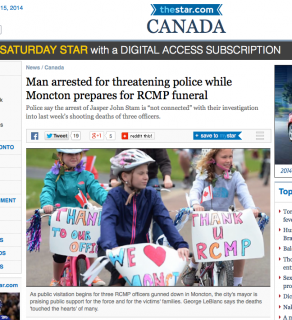
As exemplified by Adrienne Arsenault’s CBC profile of Justin Bourque, the public broadcaster in Canada seems especially prone these days to exclude a wide array of critical thought and analytical expression from our public airwaves. This propensity for exclusion and for the circling of the wagons was well displayed in the CBC’s decision at this crucial moment in our country’s history to valuate so highly the dangerous pronouncements of supposed experts on extremism rather than host a broadly-based and serious discussion of the violence done by the police as well to the police.
Adrienne Arsenault’s anonymous experts seem to give a green light to stigmatize as monsters or as potential monsters virtually anyone who leaves a fairly narrow platform of conformity and trust in authority. Our national broadcaster resorted to censorship to avoid any acknowledgement, let alone discussion, of the possible connections linking Danny Levesque’s death while in RCMP custody to the death of the three RCMP officers.
What message does the government’s persecution of Jasper Stam send to our young people? Will they conclude as they might, that any expression of kindness, consideration and respect for honesty in addressing the case of Justin Bourque is outlawed by the state even as we mourn the death of the three fallen wearers of the red tunic?
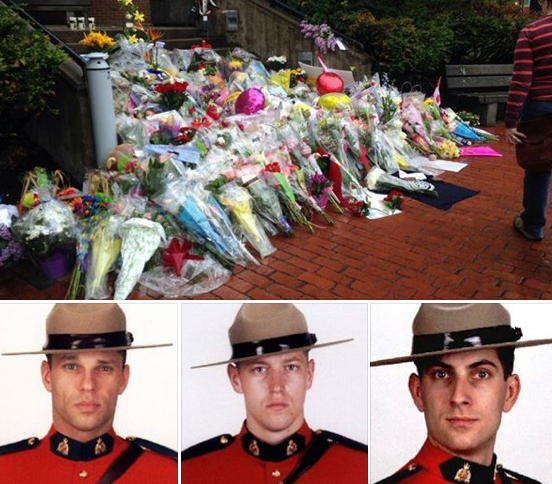
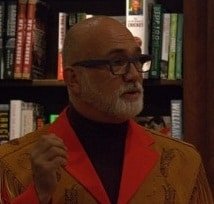
Anthony Hall is a Professor of Globalization Studies at the University of Lethbridge in Alberta Canada where he has taught for 25 years. Along with Kevin Barrett, Tony is co-host of False Flag Weekly News at No Lies Radio Network. Prof. Hall is also Editor In Chief of the American Herald Tribune. His recent books include The American Empire and the Fourth World as well as Earth into Property: Colonization, Decolonization and Capitalism. Both are peered reviewed academic texts published by McGill-Queen’s University Press. Prof. Hall is a contributor to both books edited by Dr. Barrett on the two false flag shootings in Paris in 2015.
Part II was selected by The Independent in the UK as one of the best books of 2010. The journal of the American Library Association called Earth into Property “a scholarly tour de force.”
One of the book’s features is to set 9/11 and the 9/11 Wars in the context of global history since 1492.
ATTENTION READERS
We See The World From All Sides and Want YOU To Be Fully InformedIn fact, intentional disinformation is a disgraceful scourge in media today. So to assuage any possible errant incorrect information posted herein, we strongly encourage you to seek corroboration from other non-VT sources before forming an educated opinion.
About VT - Policies & Disclosures - Comment Policy

